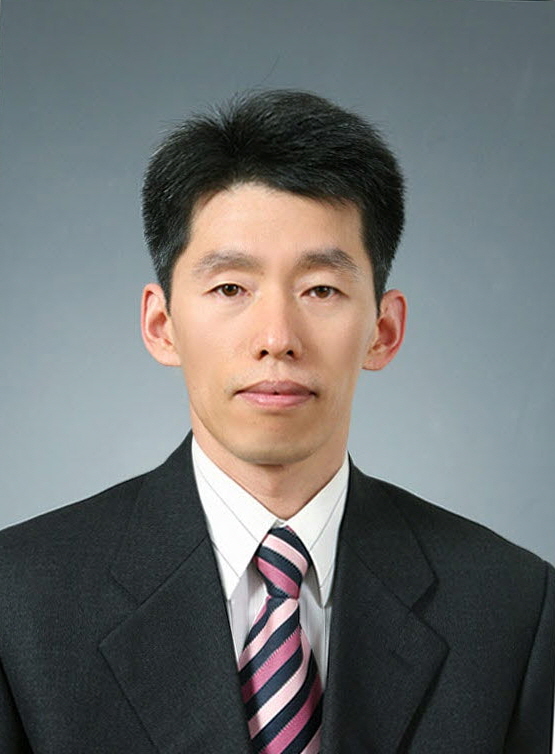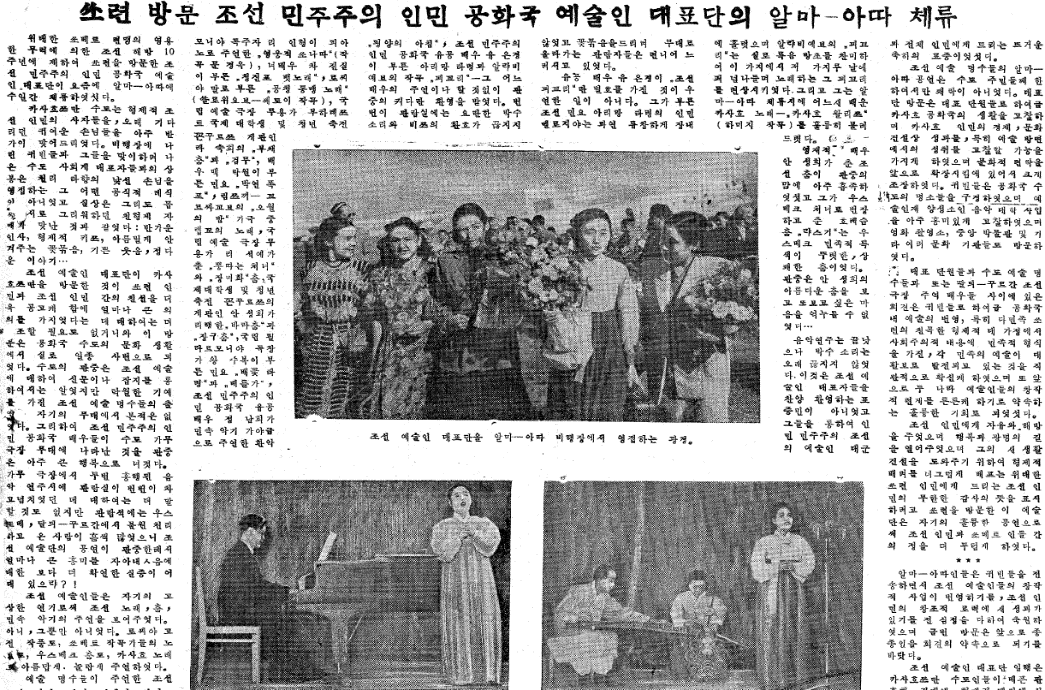Exchange and Cooperation in Music and Art between the Soviet Union and North Korea (1948–1990)
- Special Report
- November 09, 2021

- Byong-Jo LEE
- Professor at Al-Farabi Kazakh National University

Prior to the collapse of the Soviet Union, an extensive number of cultural exchange visits were made between the Soviet Union and North Korea in various fields including the arts. Mutual visits paid by delegates of the respective countries served as an opportunity to introduce cultural techniques and receive training by experts of the other country. In this Research Review, Lee Byong-Jo, Professor at Al-Farabi (Kazakh) National University, explains the exchange of arts between the two countries. While most of them have been made with the intentions of praising the North Korean regime, findings show that there have been exchanges in folk music as well. In addition, research shows that Koryoin artists in Central Asia led cultural exchange between two countries. According to articles on the Lenin Gichi, exchange visits started with the founding of North Korea and persisted until the 1960s. Art groups reflected the sorrow of the Koryoin community, encouraged them to preserve their national identity, and contributed to the development of the arts in both countries.
Beginning this article…
Upon the establishment of North Korea (1948) until the collapse of the Soviet Union (1991), active exchanges took place between these two countries in various fields, including politics, economy (agriculture), culture and art, and sports. For example, the anniversaries of the Great October Socialist Revolution (1917), the end of World War II (1945), the establishment of the North Korean government (1948), and the Korean War (1950) were grandly commemorated as events on a 10-year cycle. For these occasions, the Soviet Union organized groups to visit North Korea, while North Korea sent delegates to the Soviet Union (Moscow). Most of these visits were for political events; however, there were also periodic visits made for the exchange of art and culture, such as music, performing arts, dance, song, and circus. Unfortunately, academic research on the latter occurrence has been scarce.
During the visits, dance, singing, music, and composition techniques were presented and introduced, while musical instruments such as janggo (a Korean drum shaped like an hourglass), drums, big gongs, and kkwaenggwari (small gongs) were also exchanged. Occasionally, musicians and experts were sent to each side for short- or long-term training. The performances held by the Soviet Union were mainly led by Koryoin (Korean Diaspora) artists from Central Asia. These types of visiting performances took place during the entire abovementioned period (1948–1990), which strengthened exchanges and cooperation in music and art between the Soviet Union and North Korea and contributed to the development of the performing arts of the Koryoin community in Central Asia. In addition, it was discovered that both countries actively pursued the acquisition of music and art-related works. The Soviets obtained most of the music-related works (dances, songs, and instruments) produced in the 1950s and 1960s in North Korea. These materials are still stored in libraries in the Russian metropolitan area and some provincial cities.
To understand the current status of the collection and research of North Korean folk/national music-related materials, the author first examined the Russian State Library (formerly the Lenin State Library of the USSR). The author also examined the current status of the collections at the M. Gorky Scientific Library at St. Petersburg University, the “A. M. Gorky Public Library of Primorsky Krai” in Vladivostok in the Far East, and the “Central State Archive of Film, Photo Documents and Sound Recordings” in Almaty, Kazakhstan. To understand the exchanges of music and arts, including reciprocal performances, training, and exchange of instruments, the writer reviewed articles released in 1948–1990 in the newspaper Lenin Gichi (publishing period: 1938–1990), which best describes the overall life of Koryoin during the Soviet period.
North Korean folk music materials and research outcomes in CIS
Regarding the collection and research of North Korean folk or national music-related materials, very little or no literature or research outcomes were found online in other regions except the libraries in Moscow (this situation may vary in the case of searching offline). Most of the materials the author found were books; very few translated versions existed and papers or other materials have not been found. Most of the retrieved materials were folk songs, pop songs with revolutionary messages, and song epics seemingly praising the leaders or systems of North Korea. Although scarce, the collections related to North Korean folk music, which were partially confirmed to have been released in the 1960s, have their own value. In particular, Ham Hwa-jin's Discussion on Joseon Music and Joseon Music (Research Materials) , stored in the Russian State Library, were absent from existing publication lists of North Korea (Ham was a Korean court music conductor in 1884–1948). Music materials from 1945–1970 rediscovered in countries that made active exchanges with North Korean musical circles, such as Russia, Central Asian countries, East Germany, China, and Japan, are important not only for the reconstruction of North Korean music history, but also for the study of the integrated history of ethnic music between South and North Korea.
Exchange and Cooperation in Music and Art between the Soviet Union and North Korea
Based on the Lenin Gichi articles written in 1948-1990, the exchange activities (performances, dispatch of experts for training and exchange of supplies, and others) in music and arts between the Soviet Union and North Korea during the abovementioned period are divided into three periods as follows:
① Period from 1948 to 1960

“DPRK’s art troupe staying in Alma-Ata”, p.3 ,Sep.17, 1955, Lenin Gichi
According to articles published during this period, exchanges were actively made during this period. The visits of artistic groups began actively after the establishment of the North Korean government. Interestingly, the visits were made regardless of the political situation before and after the Korean War in the early 1950s. Let us take a closer look at some major exchange activities. The Pyongyang Arts Troupe, including a leading modern dancer Choi Seung-hee and a musician Ri Kyung-pal, visited Moscow for performances in June 1950. In October of the following year, Choi Seung-hee, Kim Wan-woo and Yoo Eun-kyung accompanied the troupe. In May 1953, the People's Army Song and Dance Ensemble, consisting of 170 members (Director Ri Chun-hyeon) performed three times in Moscow. The North Korean art troupe’s exchange visits to Uzbekistan and Kazakhstan in September 1955 are particularly noteworthy. To commemorate the 10th anniversary of liberation, the troupe led by Jeong-ryul (Jung Sang-jin) performed in Tashkent, Uzbekistan. They then stayed in Almaty for four days from September 1st to perform two shows at Abai Theater. The performances included a solo piano by soloist In-hyeong Lee (composed by Moon Kyung-ok), Cha Jin-sil's , State Arts Theater’s dancer Ra Sook-hee's fan and sword dance, Baek Rak-won's folk song , State Arts Theater’s dancer Lee Seok-ye's , , Ahn Seong-hee's < Barah Dance> and , soloist Wang Subok's folk song and , the gayageum (Korean harp) play of
② Period from 1961 to 1980
In this period, the articles show relatively few cases of exchange compared to the previous period. According to records found in the articles, only three reciprocal visits were made during this period. The first one was made in December 1966 when the Pyongyang Song and Dance Ensemble toured large cities such as Moscow and Leningrad in the Soviet Union. As the second performance during this period, the Berezka Soviet State Dance Ensemble (exceptionally made up of non-Koryoin) performed at the Pyongyang Grand Theater in February 1969. Lastly, the ‘Future-preparing Worker’s Song and Dance Ensemble’, based in Khabarovsk, visited Pyongyang in 1974. During this period, the Soviet-North Korea Friendship Association actively played the role of a channel by organizing friendly exchanges. Rather than having performances, the Association held conferences mainly in Moscow, St. Petersburg, Khabarovsk, Vladivostok, Almaty and Tashkent in Central Asia, as well as exhibitions of North Korean photos, magazines, and books. North Korean films were also screened in large cinemas.
③ Period from 1981 to 1990
The once dormant exchange visits resumed in the mid to late 1980s. There wa sa total of 18 events of performance exchange according to the articles from this period. Looking at some of them, a troupe from the Republic of Uzbekistan visited North Korea in 1987. To celebrate the Week of the Democratic People's Republic of Korea, the artists of Nampo City Art Theatre (Director Park Seung-il) performed the small drum dance and the musical at the House of Culture,‘Leninskie Printsipy’ Kolhoz, Tashkent. The meritorious artists, such as Lee Seon-ok, Kim Myeong-sook, Ro Myeong-sun, and Kim Hee-suk, sang , and several dance songs. In April the following year (1989), the Arirang Music and Dance Troupe of the Republic of Kazakhstan (Korean Theater) participated in the April Spring Friendship Art Festival (joined by five continents, 62 countries, 77 art troupes) held in Pyongyang. The show consisted of a solo singing of Nilliri by Kim Soya, ensembles of the mixed trio, fan dance (with Kim Il Sung also attending), and performed an exclusive concert in Wonsan for two days. Also, in January 1990, the last year of this period, Kazakhstan sent Taldykorgan 'Morning Dawn' Music and Dance Concerto to North Korea. At this period, exchange visits were actively carried out between the two countries.
Ending this article…
During the existence of the Soviet Union, a number of exchanges and cooperation were made in music and arts. The cases presented above are based on articles that appeared only in the Lenin Gichi in 1948-1990. So, there may be more cases from other materials that have not been covered in this article. At that time, most of the key artists were from Arirang Music and Dance Troupe of the Korean Theater (then Joseon Theater) or small arts troupes (SoinYesuldan) of Koryoin in Kolhozes or collective farms. Since the deportation migration of the Korean diaspora in 1937, the troupes have toured the Kolhozes of Koryoin in each region to alleviate the pain of forced displacement and encourage each other through traditional dances, songs, and plays. They significantly contributed to establishing the identity of the Koryoin in Central Asia.
The exchange activities ultimately influenced the development of music and art in both countries. The small local art troupes from each region virtually led the performances of the Soviet side, including the Korean Theater. North Korean music also had a significant impact on the development of the performing arts of the Koryoin community in Central Asia. For example, Koryoin preferred North Korean folk songs with modernized vocalization. As they grew up learning European, Russian and Soviet music, it seems that they were naturally attracted to the new-style folk songs. New folk songs of North Korea such as and have been very well received by Koryoin and are still sung on traditional holidays and feasts. During the first ten years after liberation, some Koryoin music influenced North Korea. One of the examples is (1945, written by Haeun Kim, composed by Victor Kim), which was popular in North Korea for a while immediately after liberation.■
■ Lee Byong-jo is a Professor in History and the Head of the Division of Korean Studies in Department of the Far East at Al-Farabi Kazakh National University. He obtained his BA and Ph.D. at the Hankuk University of Foreign Studies in Russian Language. His areas of interest include Central Asia Korean Studies, including Siberian and Far Eastern missionary activities of the Russian Orthodox Church from mid-19th century to the early 20th century, Korean immigrants and culture in Russia, CIS, and Kazakhstan.
■ Typeset by Seung Yeon Lee | Research Associate
For inquiries: 02 2277 1683 (ext. 205) | slee@eai.or.kr